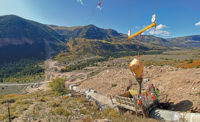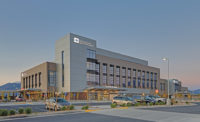For the second time in as many years, contractors working to replace the 1.1-mile-long North Fork Siphon pipeline in the rugged Uinta Mountains of northern Utah are utilizing a cable crane system that’s the first of its kind in the U.S., the project team says.
Officials for the Central Utah Water Conservancy District (CUWCD) say the unique cable system, which resembles the chairlifts at nearby ski areas, is helping to complete the three-year, $28-million project quickly. It also has less environmental impact and costs less than more conventional methods of moving materials and equipment. But COVID-19-related travel restrictions nearly left the system grounded this summer.
Officials at CUWCD had been watching the North Fork Siphon in the state’s high Uinta range for several years. The siphon, which moves water between two reservoirs, was completed in 1987 using prestressed concrete cylinder pipe (PCCP), which in ensuing years has accumulated a record of failure in water systems around the world.
“We knew there were problems with this kind of pipe for years,” says Daryl Devey, a project manager for the CUWCD. The agency builds and maintains the system of reservoirs, tunnels and pipelines that deliver water from Utah’s northern mountains to the farms and urban centers in the southern valleys, under the direction of the U.S. Bureau of Reclamation.
High Altitude, High Anxiety
“We had a section of the Jordan Aqueduct [in the southwest corner of Salt Lake Valley] blow out in the mid–’80s, and it caused a lot of problems, and we’d seen failures in systems in other parts of the country. The siphon is under pressure, about 700 psi at some points, so it was a particular concern,” he says.
The North Fork Siphon is part of a system of tunnels and river diversions, including the Upper Stillwater Reservoir at an elevation of 8,176 ft, that delivers an average of 100,000 acre-ft of water annually into Strawberry Reservoir at an elevation of 7,612 ft.
“The environmental damage to that area from the pipe blowing out would be catastrophic.”
– Troy Ovard, Stillwater Area Manager, CUWCD
Carrying approximately 285 cu ft per second (cfs) of water from the Stillwater Tunnel, the siphon descends 700 ft down a 55-degree grade to the floor of a mountain valley bisected by the North Fork of the Duchesne River. The siphon runs 1,500 ft across the valley floor, under the river and takes on an additional 30 cfs of water from a diversion 2.5 miles upstream on Hades Creek, a tributary to the Duchesne.
The combined 305 cfs of water is then moved 680 ft up a 70-degree grade into the Hades Tunnel, which joins the greater Strawberry Reservoir collection system.
Troy Ovard, Stillwater area manager for the CUWCD, says continued concerns about the integrity of the pipe over the years led to more and more sophisticated inspections. Working with consulting engineers at New Jersey-based Openaka and Pure Technologies, the pipes were scanned using electromagnetic imaging to peer through the concrete and check the condition of the highly tensioned wires inside.
“In 2009, we did our first electromagnetic testing and inspection. It revealed a few problem areas, and we did find some broken wires, but not too many,” Ovard says. “The inspectors came back in 2014 and did another electromagnetic inspection, which showed even more wire breaks. At that time, they recommended replacing the pipe.”
Devey says agency officials knew they needed to act soon, especially given the location of the siphon. “The environmental damage to that area from the pipe blowing out would be catastrophic,” he says. “We couldn’t continue to risk the potential impacts to the environment, the recreation community, our customers and reputation. We have to have a reliable source of water for Strawberry Reservoir.”
Plans for the replacement were developed by AECOM and work got underway in 2018.
Cable From Austria
Brigham City, Utah-based Whitaker Construction, a firm specializing in underground and pipeline infrastructure, submitted a proposal utilizing the cable crane system.
“Some of our guys had seen one [cable crane] working before and felt like it could be a good solution for this project,” says Quinn Hamson, project manager for Whitaker Construction.
Ovard says officials at CUWCD liked Whitaker’s proposal for a number of reasons. “The cable crane has less impact on the environment. Other proposals had plans to cut new switchback roads up the hill. There is also a safety issue because it can get very muddy here, and those roads can get slippery. This is a very steep slope to work on,” Ovard says.
“Whitaker showed us the cable crane can also expedite the process. It can move the pipe right where they want it, and they can also use it to place backfill, CLSM [controlled low-strength material] concrete and even the drilling rigs we need to drill into the rock for the anchor blocks that hold the pipe in place on the slope,” he says.
Whitaker purchased the $1.5-million piece of equipment from Gantner, based in Sulz, Austria. It consists of two 80-ft-tall towers and spools of cable that can reach up to 2,000 ft. The system uses a diesel-powered winch at the top to move material up or down the slope while a separate diesel-powered winch mounted on the cable lifts and lowers material. The system can carry up to 22 tons. The replacement pipes are 89-in.-dia steel-reinforced concrete in 40 ft lengths. Whitaker completed the north side portion of the siphon in 2019.
“This is a much better pipe that we expect to last for 75 to 100 years,” Ovard says.
In addition to the cable crane, a bulldozer outfitted with a winch will be secured at the top of the slope and tethered to a track hoe, which will dig the trench on the hillside before pipework begins.
“This is similar to what we did on the opposite side of the valley last year, except we didn’t have the dozer anchored at the top. It will give us some flexibility and redundancy,” Hamson says.
The replacement siphon is being constructed 60 ft from and parallel to the existing pipeline, which will remain in operation until the system is fully switched over later this year.
COVID-19 Cable Kink
For the first year of work with the cable crane in 2019, a rigging team from Austria came to the site to assemble and help test the system, but this year, project managers got an unwelcome surprise.
“The team from Austria was not allowed into the U.S. because of COVID-19 travel restrictions,” Ovard says.
Hamson says he and other Whitaker team members were sent scrambling to find qualified replacements. “We’d had an independent company who did the testing of the crane system for us. They also test ski lifts, and they knew some people in the U.S. and Canada who did this kind of rigging. We were able to get them to come do the setup this year,” Hamson says. “It was a bit of an effort and put us a little behind schedule.”
By the middle of July, the crane system was in place and being tested.
In addition to the replacement siphon, Ovard says improvements have been made to related components of the system.
“All the power and communications for the Upper Stillwater Dam come through here. The power cable and fiber-optic line run alongside the pipeline and into the tunnel,” he says.
The scope of the work also has included a new metering system at the Hades Diversion and replacement of a bridge over the Duchesne River that was prone to tree snags and restricted the movement of fish.
The project is expected to be complete and in operation by November of this year.









